Rabu, 31 Oktober 2012
Kerak Telor (rice egg snack)
Kerak telor is an old style Betawi Indonesian food, that includes both sticky rice and egg, fried in a pancake or omelette shape and topped with fried shredded coconut and fried shallots. I personally think it’s one of the most interesting and fun snacks to watch being prepared.
In order to make kerak telor, the vendor takes a handful of soaked sticky rice and places it on the bottom of a charcoal heated wok. An egg goes in, and then at just the right time, the entire wok is flipped over (and somehow the rice cake miraculously doesn’t fall out) and roasted over the fire. For me, this was one snack that was more fun to watch being made than to eat.
Where: You’ll often find kerak telor at public areas like around the National Monument in Jakarta and Fatahillah Square in mid to late afternoon.
Senin, 29 Oktober 2012
Durian (King of Fruits)
Similar to stink beans, I just couldn’t leave durian off this food guide because I think it’s just one of the ultimate natural things in the entire world… and it’s definitely considered the King of Fruits in Indonesia. Jakarta is not nicknamed “the Big Durian,” for no reason.
You’ll find an abundance of fresh durian around Jakarta, many of which come from Medan or Palembang, or other islands as well. Along with eating a fresh durian, there are also many different durian treats, like durian cake, durian ice cream, and the very popular and refreshing es campur durian, durian flavored mixed shave ice. Also, be sure to check out my friend Lindsay’s amazing Jakarta durian guide.
Where: I had a few Medan and Palembang durians along Mangga Besar road in the evening.
Jumat, 05 Oktober 2012
Fried Chicken Wings

IFC could be a worthy rival for KFC.
The key to Indonesian fried chicken is the use of small village birds, whose freedom to run around the yard makes them tastier than the big chunks of meat at KFC.
Variations on that chain have cropped up across the country -- rumor has it that one of these was founded by a polygamist, so franchisees must have multiple wives.
Ayam Goreng Suharti, Jalan Kapten Tendean No. 13, Mampang Prapatan, Daerah Khusus Ibukota Jakarta; +62 21 525 4595
Rabu, 19 September 2012
Bakpao
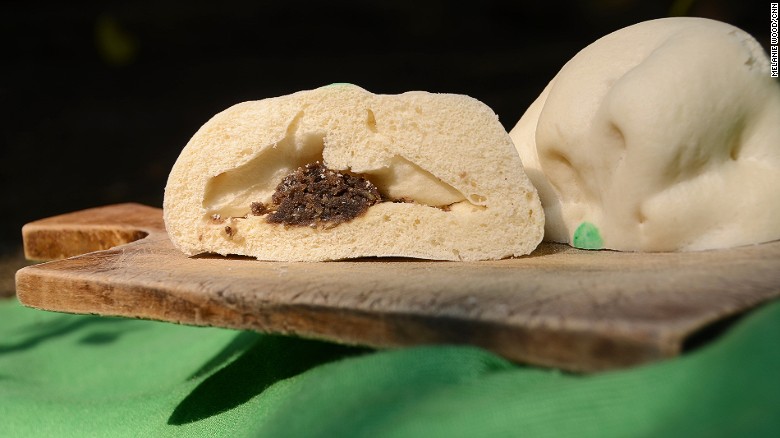
The best thing about rush hour.
Jakarta gridlock may be a blessing for the bakpao market.
Vendors often line busy roads during rush hour to offer these fluffy meat-filled buns to hungry passersby in need of a snack.
Sweet offerings include chocolate and green bean, indicated by a colored dot on top.
No need to go in search of them, they'll find you.
Jumat, 07 September 2012
Rawon
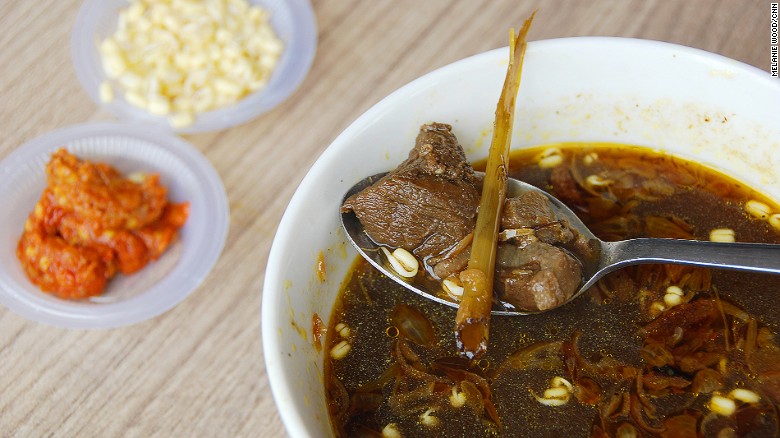
Dark soup. Colorful past.
A beef stew from East Java that goes heavy on the keluak nut to give it a nutty flavor and a deep, black color.
The soup base also mingles with garlic, shallots, ginger, turmeric and red chili to make it nice and spicy.
The most famous variant is called Rawon Setan (Devil's soup) in Surabaya.
Rawon Setan, Jl. Embong Malang, Kota Surabaya, Jawa Timur
Senin, 13 Agustus 2012
Martabak Crepe with egg and vegetarian
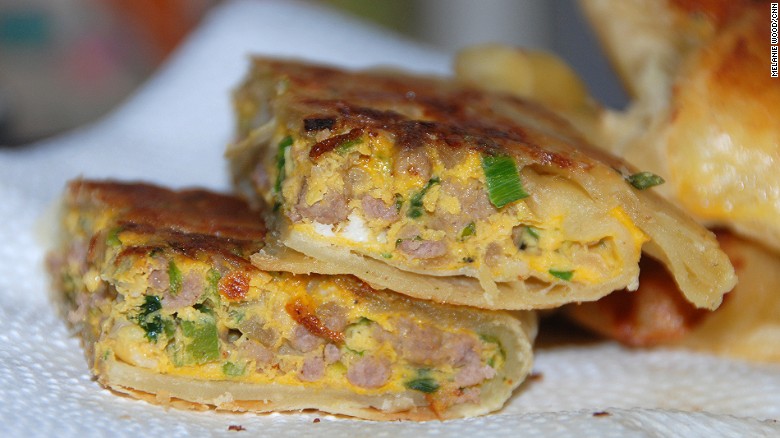
You can make it without lard. But why bother?
Think of a spongy, thick crepe made with 10 times the lard and you'll be somewhat close to imaging martabak.
The sweet version looks more like a pancake filled with gooey chocolate, peanuts or cheese, while the savory one is made from crispy pulled pastry like filo that is flattened in a wok as egg and minced meats are rapidly folded in.
Served with pickled cucumber and a sweet and sour vinegar.
Martabak Ayah, Muhammad Daudsyah, Jl. Tgk Diblang, Kota Banda Aceh
Rabu, 01 Agustus 2012
Sate Ayam / Sate Kambing (satay)

I’ve had a lot of different types of sate (or satay) in Southeast Asia, but there’s nothing that compares to real Indonesian sate; In my opinion you’ll find some of the absolute best sate in Asia within Indonesia. in Indonesia you’ll find many different types and varieties of sate, but two of the common versions in Jakarta at sate ayam (chicken sate) and sate kambing (goat sate).
One of the common recipes includes the meat marinated in sweet kecap manis soy sauce, before being skewered. I think is the main reason why Indonesian sate is so good, is because the skewers of meat are typically grilled on an extremely hot charcoal fire, so the meat cooks quickly, while leaving it smoky and juicy.
Where: Sate H. Romli in south Jakarta serves delicious sate ayam and sate kambing. Address: Jalan Kyai Maja No.21, Melawai, Kby. Baru, Kota Jakarta Selatan, Daerah Khusus Ibukota Jakarta; Open hours: 10 am – 12 midnight daily; Prices: I paid 67,000 IDR ($4.99) for 2 plates of sate.
Selasa, 31 Juli 2012
Pecel Lele (fried catfish)
Deep fried catfish, known as pecel lele, is a very famous and common Indonesian street food, often served at street side restaurants and local food tents known as warungs. In Jakarta, mostly at night, if you drive around the streets you’ll see countless food stalls showcasing catfish on their banner menus.
The catfish are prepared pretty simple, just salted and sometimes rubbed with some coriander and turmeric, and then deep fried until extra crispy all the way through. The catfish I ate in Indonesia were pretty small, about the size of a sausage, so when they were deep fried they almost turned chip-like, fried solidly.
Once again, the secret of the flavor when eating pecel lele lies within the sambal that it’s always served with. You take a piece of crispy catfish, mix it with your rice, add on some sambal, and that’s a recipe for a delicious bite.
Where: Permata Mubarok 1 is a little far from central Jakarta, but a nice street food tend. Address: Komplek Permata Buana, Jalan Puri Kembangan, Puri Indah, Jakarta; Open hours: 5 pm – 10 pm daily; Prices: 125,000 IDR ($9.41) for 4 people.
Selasa, 24 Juli 2012
Tahu gejrot ( Tofu and Spicy Sauce)
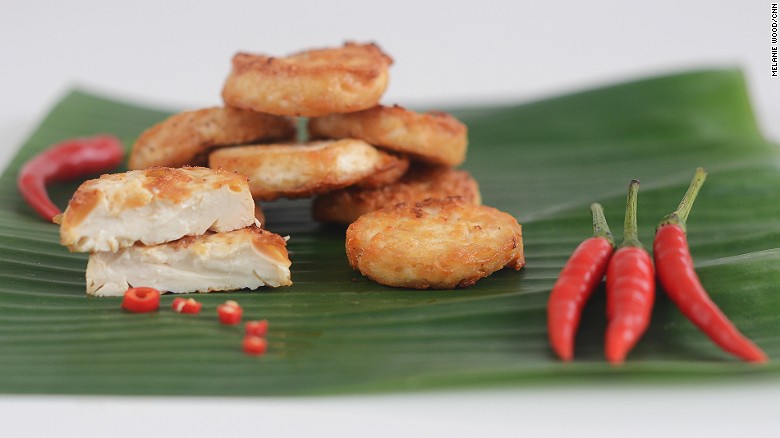
Reason number 467 to love tofu.
These clouds of golden, fried tofu look like little packages behind the windows of the boxes from which they are sold.
Tofu is a poor man's snack, but that also makes it prevalent.
Menteng Plaza has a version of fluffy tofu steeped in sweet soy sauce and chili and served in a pestle and mortar.
Taman Menteng, Jl. HOS Cokroaminoto, Jakarta
Sabtu, 23 Juni 2012
Spicy Chicken Noodle
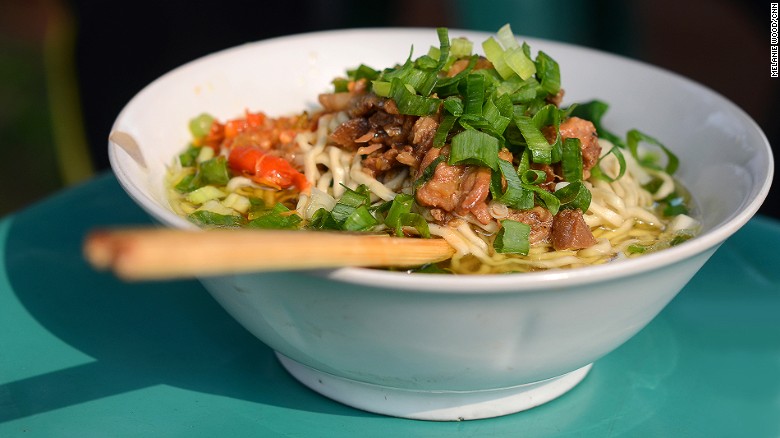
In search of the perfect noodle dish? Stop here.
For this dish, bakmie is boiled in stock and topped with succulent slices of gravy-braised chicken.
Chives and sambal add extra flavor -- but if it's done right little else is needed.
Unlike most Indonesian cuisine, where the secret is in the sauce, the clue to a good mie ayam is the perfect al dente noodle.
Bakmi Orpha, a hole in the wall in west Jakarta, draws Ferrari-owning clientele for its deceivingly tasty mie and wontons.
Bakmi Orpha, JL. Malaka II No. 25, Daerah Khusus Ibukota Jakarta; +62 21 691 2450
Jumat, 08 Juni 2012
Beef Rendang (rendang)
When CNN took a survey to come up with the world’s best foods, Indonesian rendang is the dish that took the number 1 spot. Although some things on the list (potato chips?) are questionable, I’m quite alright with rendang being the winner. Rendang is truly an outstandingly delicious Indonesian food.
Often made with beef, rendang is a dish that originates in the western part of Sumatra from the Minangkabau people, and is commonly served at Nasi Padang restaurants. Rendang is popular across Indonesia and also in Malaysia and Singapore.
There are two main variations of rendang, one that’s quite dry (this is supposedly the original authentic version), with all the spices coated onto the meat, and another that has a more of a curry gravy sauce to it. Both are fantastic, depending on your preference; I don’t think I can pick a favorite.
In order to make rendang, spices like cinnamon, star anise, cardamom, and dry chilies, garlic, and shallots are cooked with the meat. Where the recipes differs from other curries is that one of the key ingredients is desiccated coconut, which gives the rendang curry a grainy texture of the dry coconut, mixed with all the incredible spice flavors.
Where: Again, this is a dish available at Nasi Padang restaurants throughout Indonesia. Rumah Makan Surya Masakan Padang; Address: Jalan Bendungan Hilir Raya No.15, Bendungan Hilir, Jakarta; Open hours: 9 am – 8 pm daily; Prices: I paid 165,000 IDR ($12.52) for a bunch of dishes.
Senin, 07 Mei 2012
Babi Pangang (Batak grilled pork)
On a spur of the moment decision, my wife and I decided to eat at a restaurant in Jakarta that served Batak food, from the Lake Toba region of Sumatra. One of the traditional Batak dishes, is something called babi pangang (sometimes babi panggang), which is a type of grilled or roasted pork.
From my understanding, babi pangang can refer to grilled pork many different ways, but the version I had was nice and salty, and had the most incredible grill fire roasted flavor of just about any grilled pork I’ve ever had. And additionally, the pork itself was incredibly well marbled, not too fatty, but with a great ratio so it was still juicy and succulent.
Where: Lapo Ni Tondongta is a famous Batak restaurant in Jakarta, and the grilled pork was amazing. Address: Jalan Gelora Los A1, Senayan, Jakarta; Open hours: 10 am – 10 pm daily; Prices: I paid 88,000 IDR ($6.62) for a meal for 2 of us.
Rabu, 14 Maret 2012
Gulai Kepala Ikan (fish head curry)
When I published my Singapore food guide, I received a few comments from Indonesians saying, “you have to come to Indonesia to try our fish head curry.” And so there was no way I was going to miss out on Indonesian fish head curry.
Fish head curry is a pretty general term, and whole fish are eaten around Indonesia, so I guess I would classify a dish as a fish head curry when the head is the dominant piece of the fish included in the dish. You’ll find fish head curry as some Nasi Padang and Sumatra restaurants, and the best fish head curry I had was at Medan Baru Restaurant in Jakarta. The fish head was covered in one of the most creamy coconut curries I’ve ever experienced in my life – it was unbelievable.
Where: Rumah Makan Medan Baru; Address: Jalan Krekot Bunder No. 65, Pasar Baru, Sawah Besar, Jakarta; Open hours: 9 am – 9 pm daily; Prices: Ou total bill was 406,000 IDR ($30.69) for many dishes and a huge fish head.
Senin, 13 Februari 2012
Jengkol Pedas (jengkol chili, djenkol)
Although jengkol beans, which grow in a pod, are commonly eaten throughout Southeast Asia, and a delicacy in Indonesia (and I have to admit that I really love them) they are potentially poisonous due to their jengkolic acid.
Jengkol beans are eaten in a variety of ways, and when I’m at home in Thailand, I typically eat them raw like a garnishing nut or vegetable. But when I was in Jakarta, I enjoyed jengkol beans a few times, once while eating an amazing home-cooked Sundanese meal, and another time at a Betawi restaurant, a dish called jengkol pedas. When jengkol beans are cooked, they are starchy, kind of like potatoes, but with a gummy texture.
Where: Warung Mak Dower serves Betawi food in Jakarta, and I was especially impressed with the jengkol pedas. Address: Jl. Pemuda No. 72, Rawamangun, Jakarta; Open hours: 9 am – 9 pm daily; Prices: 140,800 IDR for a full spread of dishes.
Jumat, 06 Januari 2012
Delicious Food. There is so many topping on the rice
Singaporeans may say they can't live without it, but nasi padang, named after its birth city in Sumatra, is 100% Indonesian.
Nasi padang is a meal with steamed rice accompanied by more than a dozen dishes -- goopy curries with floating fish heads or rubbery cow's feet -- stacked up on the table.
The best way is to chuck away the cutlery and dig in with hands then wash the spice away with a sweet iced tea.
Garuda Nasi Padang, Jl. Gajah Mada no. 8, Medan, Sumatra
Langganan:
Postingan (Atom)







